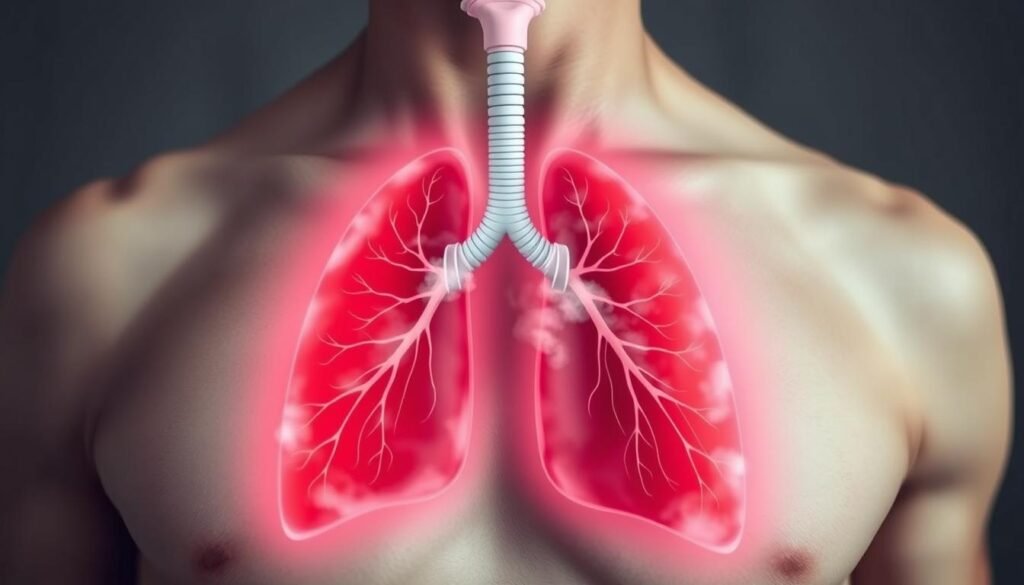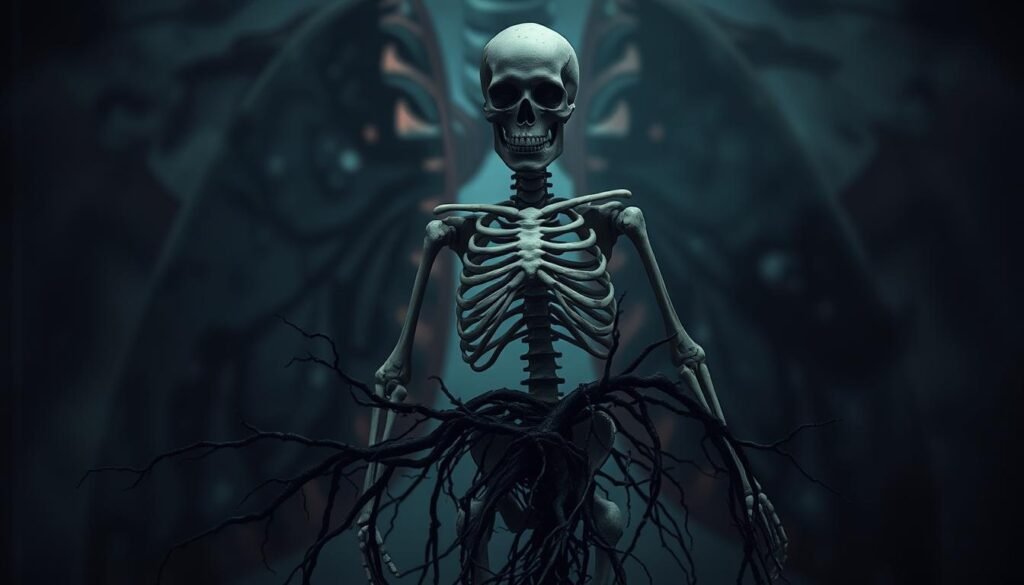Non-Small Cell Lung Cancer (NSCLC) makes up about 84% of all lung cancer cases. It’s vital to spot the early signs of this major health issue. Spotting it early can greatly help with treatment. Yet, many people don’t notice the early warning signs. Symptoms like ongoing coughing, pain in the chest, and feeling very tired might seem minor. But for NSCLC, they need quick action. It is essential to know how to spot these symptoms. Quick action can lead to a better treatment plan. Knowing early can increase the chances of getting the right help fast.
Key Takeaways
- NSCLC represents the majority of lung cancer cases.
- Early symptoms may include persistent coughing and chest pain.
- Timely recognition is essential for effective treatment.
- Awareness of lung cancer symptoms can lead to improved outcomes.
- Supportive therapies are available to manage treatment side effects.
Understanding Non-Small Cell Lung Cancer
Non-Small Cell Lung Cancer (NSCLC) is the most common lung cancer type, making up about 85% of cases. It includes several types of lung cancer, like adenocarcinoma, squamous cell carcinoma, and large cell carcinoma. These cancers start in lung cells and can grow uncontrollably, spreading through the body.
Many facts highlight the importance of understanding lung cancer. Tobacco use is the biggest factor, causing 90% of lung cancers. The amount and length of time someone smokes increases their risk. Adenocarcinoma is a standout because it’s common in smokers and non-smokers alike.
The survival rate for NSCLC changes a lot based on how early it’s found. If the cancer hasn’t spread, the 5-year survival rate is 65%. But, it drops to 9% if it has spread to other parts of the body. The stage of the cancer is key to deciding on a treatment plan.
Treatment might include surgery, chemotherapy, or other therapies. The goal is either to manage or cure the cancer, depending on how far it has spread.
It’s crucial to know the symptoms of this cancer. Many people don’t have symptoms until the cancer is advanced. This highlights the need for regular doctor visits and screenings.
Common Early Symptoms of Non-Small Cell Lung Cancer
It’s critical to spot early symptoms of non-small cell lung cancer quickly. Many times, these symptoms seem like other health issues. Being aware is key. Look for signs like a lasting cough, blood when you cough, and pain in the chest. These symptoms are important clues for spotting lung cancer early.
Persistent Cough
A lasting cough is a common early sign of lung cancer. This cough sticks around and doesn’t get better. It might seem like a cold or allergies at first. But if it gets worse, it’s time to check it out. It could be something serious like lung cancer needing a closer look.
Coughing Up Blood
Seeing blood when you cough is a big warning sign. Even a little blood means you should see a doctor fast. For some people, about 7%, it’s the first hint of non-small cell lung cancer. This symptom is called hemoptysis and is something you can’t ignore.
Chest Pain
Chest pain is a common sign of lung cancer. It happens when you breathe deeply, cough, or laugh. This pain might mean the cancer is growing and pushing on things inside. If you have chest pain that you can’t explain, see a doctor soon. It makes a big difference in catching cancer early.
| Symptom | Description | Action Required |
|---|---|---|
| Persistent Cough | A cough that does not go away or worsens over time | Seek medical evaluation |
| Coughing Up Blood | Presence of blood in sputum | Immediate medical attention needed |
| Chest Pain | Pain felt in the chest, often worsening with movement or cough | Consult a healthcare provider |
Breath-Related Symptoms
Breath-related symptoms can tell us a lot about lung cancer. Finding these signs early can help save lives. People might feel shortness of breath or constant wheezing. These can be clues to serious health problems like lung cancer. Knowing what these signs mean is crucial for getting help fast.
Shortness of Breath
Shortness of breath can show up if tumors block the air passages or make the lungs work poorly. This might happen all at once or bit by bit. It can make everyday tasks much harder. If you’re often out of breath and you don’t know why, you should see a doctor soon.
Wheezing
Wheezing is a high sound you make when you breathe. It can happen if the airways are tight and can be mistaken for asthma. If you keep wheezing, it’s important to talk to a doctor. This way, you can check if it’s a sign of *lung cancer symptoms* and get the right treatment.

Additional Early Symptoms of Non-Small Cell Lung Cancer
It’s key to catch early symptoms of NSCLC quickly for speedy treatment. Symptoms like losing weight, feeling tired, and a raspy voice may seem minor but are important. They could signal non-small cell lung cancer. Finding these early can improve treatment success.
Weight Loss
Unexplained weight loss should raise red flags. NSCLC patients may not feel hungry and lose weight without trying. It’s important to see a doctor if you notice these warning signs to find out why.
Fatigue and Weakness
People with NSCLC often feel very tired and weak. This tiredness isn’t linked to how active you are. Getting checked by a doctor can explain why you feel so drained.
Hoarseness
Hoarseness happens when tumors affect the larynx or nerves around it. Spotting this early is crucial for checking out if it might be cancer, including NSCLC. See a doctor if your voice stays hoarse.

To learn more about these symptoms, check out this detailed resource. Knowing these signs can lead to earlier treatment and better health management.
| Symptom | Description |
|---|---|
| Weight Loss | Unexplained reduction in weight indicating potential health complications. |
| Fatigue | A persistent feeling of tiredness unrelated to activity levels. |
| Hoarseness | Changes in voice quality due to potential tumor growth affecting the larynx. |
Signs of Cancer Spread
Knowing about the signs of Non-Small Cell Lung Cancer spread is key when the disease advances. It can spread to many body parts, leading to various symptoms. You might notice severe bone pain or get infections over and over again.
Bone Pain
Bone pain happens often when cancer reaches the bones, like the back and hips. This pain can stick around and change in how bad it feels. It’s crucial for people to tell their doctors about any new pain. Knowing where the pain comes from helps in planning the right treatment.
Recurring Infections
Getting sick a lot can be a sign that lung cancer has spread, especially if the immune system is weak. People might keep getting bronchitis or pneumonia that doesn’t go away with usual medicine. If someone gets a lot of chest infections, it may mean the cancer has impacted their lungs or immune system. This needs quick check-up by doctors.

| Symptom | Description | Potential Cause |
|---|---|---|
| Bone Pain | Aching in the bones, particularly in the back or hips. | Metastasis to bone. |
| Recurring Infections | Frequent illnesses such as bronchitis or pneumonia. | Compromised lung function or weakened immune system. |
When to See a Doctor
Lung cancer is the top cause of cancer deaths in the US. If you have lasting symptoms, seeing a doctor is important. Catching it early can make treatment more successful.
Symptoms to watch for include ongoing coughs, losing weight without trying, or feeling short of breath.
If you smoke or used to, it’s key to know when to see a doctor for lung cancer. People 50 to 80 who’ve smoked a lot should get checked every year. A low-dose CT scan can help find any issues early, helping treatments work better.
Screening can be a lifesaver and is often paid for by Medicare and many insurances. Make sure you go to a place with experts for the best results. Stay alert to your body and see a doctor if something feels wrong.
Quitting smoking is a major way to prevent lung cancer. Getting checked regularly can catch cancer early when it’s most treatable.
Want more info on catching lung cancer early? Check out this helpful page.
Risk Factors and Causes of Non-Small Cell Lung Cancer
Knowing what causes lung cancer helps us stop it. Smoking is the biggest reason behind Non-Small Cell Lung Cancer (NSCLC). It’s linked to about 80% of all deaths from this disease. Smokers and those around smoke face serious risks. This puts secondhand smoke as the third biggest cause of lung cancer in the U.S.
Radon gas is the second big cause, hitting non-smokers hard. This gas is hard to notice and comes from the earth breaking down uranium. People with lung cancer in their family, and those around asbestos, face more risk too. Working with asbestos and smoking make lung cancer even more likely.
The table below sums up major risk factors for Non-Small Cell Lung Cancer and their effects:
| Risk Factor | Description | Relative Risk |
|---|---|---|
| Smoking | Leading cause, accountable for around 80% of lung cancer deaths. | High |
| Secondhand Smoke | Third most common cause, contributes to many cases annually. | 1.14 to 5.20 |
| Radon Exposure | Second-leading cause, particularly affects non-smokers. | Significant |
| Asbestos | Occupational exposure increases risk dramatically. | Several times higher |
| Radiation Therapy | History of chest radiation raises lung cancer risk. | Increased |
| Air Pollution | Long-term exposure contributes to lung cancer risk. | Moderate |
| Family History | Higher risk among individuals with a familial lung cancer history. | Increased |
| Physical Inactivity | May slightly increase the risk of developing lung cancer. | Low |
Recent research points to genetics, especially certain markers on chromosome 15. These markers might make lung cancer and getting hooked on nicotine more likely. Marijuana smoke is risky too, because of its tar. Also, we need to study new things like e-cigarettes more, as they are considered tobacco products.
Early Symptoms of Non-Small Cell Lung Cancer: Importance of Recognition
Knowing the early symptoms of Non-Small Cell Lung Cancer is key for better treatment outcomes. This type of lung cancer leads to many deaths. Spotting it early means patients can get surgery, radiation, or chemo, improving survival chances.
Teaching people to notice these symptoms can save lives. If someone has a lasting cough, loses weight without trying, or feels very tired, they should see a doctor right away. Finding lung cancer early means more chance of beating it.
A study showed some lung cancer symptoms appear months before finding the disease. This underlines how vital it is to know about these early warnings. Knowing more about lung cancer helps everyone be more aware.
| Symptom | Significance |
|---|---|
| Persistent Cough | Common early symptom; may indicate lung changes |
| Coughing Up Blood | Critical warning sign for serious conditions |
| Weight Loss | Indication of cancer progression or severity |
| Fatigue | Can be a sign of underlying malignancy |
| Chest Pain | May signal tumor growth or lung involvement |
It’s crucial to pay attention to lung cancer symptoms for early action. Knowing these signs can lead to quick treatment. People can better fight lung cancer when they understand its early signs. For more about handling lung cancer, check here.
Conclusion
Knowing the early signs of Non-Small Cell Lung Cancer is key to better treatment chances. A chronic cough is seen in 65% of cases, making it important to catch early. When you see symptoms like coughing up blood or chest pain, it’s time for urgent medical help.
Raising lung cancer awareness helps fight the stigma and fear. It leads to people taking their health more seriously. With regular check-ups, early detection is more likely. This is crucial since 80% to 85% of lung cancers in the U.S. are Non-Small Cell Lung Cancer.
Lung cancer is the top cause of cancer deaths in the U.S. So, spreading the word about its early signs is vital. Education and proactive health measures can lower late-stage diagnoses. This improves patient chances against this illness significantly.